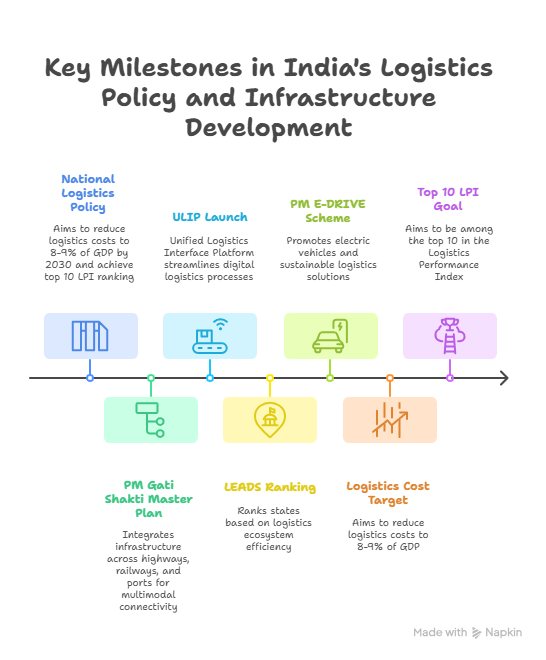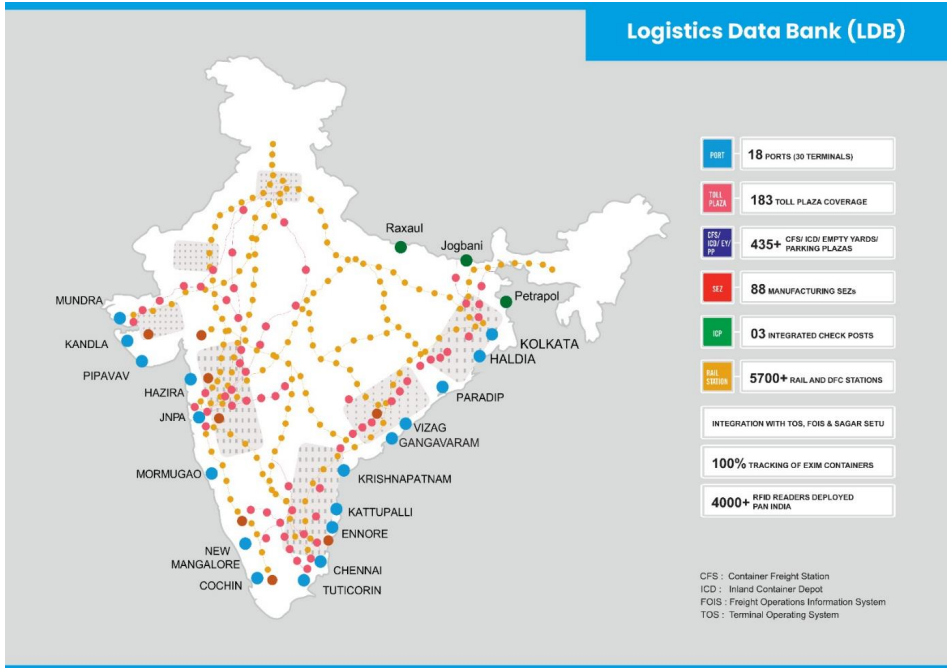Indian Economy
Logistics for India’s Global Trade Ambitions
This editorial is based on “A key driver of India’s economic ambitions,” published in The Financial Express on 20/05/2025. The article underscores the critical role of logistics efficiency in bolstering India’s global trade competitiveness, particularly in light of evolving US tariffs and India’s aspirations to achieve USD 2 trillion in exports by 2030.
For Prelims: Unified Logistics Interface Platform (ULIP), PM Gati Shakti National Master Plan, Logistics Data Bank (LDB), Special Economic Zones (SEZs), Radio Frequency Identification (RFID), HSN Code, National Manufacturing Mission.
For Mains: Strategic Importance of Logistics in Global Trade, Challenges in India’s Logistics Ecosystem, Measures to Enhance Export-Led Growth through Logistics Reforms.
India’s logistics sector stands at a critical juncture as the nation aspires to transform into a global manufacturing powerhouse and achieve its ambitious export targets of USD 2 trillion by 2030. In a world reshaped by geopolitical uncertainties, shifting trade dynamics, and supply chain realignments, logistics efficiency has emerged as a non-negotiable pillar for trade competitiveness. The urgency to fortify India’s logistics ecosystem through rapid modernization, infrastructure integration, and policy coherence has intensified, driven by the need to align domestic capabilities with global market demands.
While initiatives like the PM Gati Shakti National Master Plan, Unified Logistics Interface Platform (ULIP), and Logistics Data Bank (LDB) have laid a robust foundation, challenges such as fragmented multimodal connectivity, underdeveloped port-led industrial zones, and skill gaps in tech-driven logistics operations persist. Strategic interventions ranging from sector-specific logistics parks for electronics and textiles to AI-powered customs systems are essential to bridge these gaps and capitalize on emerging global trade opportunities.
What is the Strategic Importance of Logistics in Global Trade?
- Boosting Trade Competitiveness: Efficient logistics systems directly enhance a country’s trade competitiveness by reducing costs, improving reliability, and speeding up delivery times.
- According to the World Bank, improving logistics can boost trade by up to 15% in developing economies.
- For example, Abu Dhabi’s logistics sector contributes over 10% to its GDP and supports more than 100,000 jobs, demonstrating how robust logistics drive economic growth and global market access.
- Enabling Export Growth: As trade volumes rise, building logistics capacity, such as sector-specific logistics parks and upgraded port operations, becomes essential.
- India’s logistics sector, valued at USD 338 billion in 2023 and projected to reach USD 800 billion by 2030, is a cornerstone for achieving its export targets.
- Initiatives like the Jawaharlal Nehru Port SEZ in Mumbai, which integrates warehousing and transport, have streamlined export processes and reduced turnaround times.
- Leveraging Advanced Technology: Integrating advanced technologies like AI, IoT, and real-time tracking has transformed logistics by increasing speed, transparency, and efficiency.
- The World Trade Organization (WTO) estimates that digital trade facilitation can cut trade costs by 14.3%.
- Companies such as Amazon and JusLink use predictive analytics and automation to optimize inventory and reduce delays, leading to faster and more reliable deliveries.
- Strengthening Infrastructure: Investments in multimodal transport networks, logistics parks, and port-led industrial zones are critical for reducing logistics costs and supporting manufacturing growth.
- India’s government allocated USD 132.85 billion for logistics infrastructure in 2024–25, focusing on highways, railways, and warehousing.
- China’s port-industrial cluster model, replicated in India’s Sagarmala program, has shown how integrating ports with manufacturing hubs can lower export costs and improve efficiency.
- Building Skilled Workforce & Innovation: A digitally skilled workforce and a strong innovation ecosystem are essential for managing modern, technology-driven logistics.
- India’s initiative to skill 2 million youth in logistics over five years aims to meet industry demand for digital and technical expertise.
- Globally, logistics startups and public-private partnerships are driving innovation in automation, predictive analytics, and supply chain optimization.
State of Logistics Sector in India
- Economic Significance & Employment: India’s logistics sector contributes about 14.4% to the GDP and supports the livelihoods of over 22 million people.
- Market Size & Structure: In 2019, the logistics sector was valued at Rs. 15.1 lakh crore (USD 190 billion), with 99% of it being unorganised, including small truck owners, brokers, warehouse owners, and freight forwarders.
- Progress & Digitalization: India’s logistics improvements are reflected in its rising scores on UNESCAP’s Global Survey on Digital and Sustainable Trade Facilitation, from 63.4% in 2015 to 90.3% in 2021, indicating enhanced trade facilitation and technology adoption.
- Sector Composition: The sector comprises 37 export promotion councils, 40 Participating Government Agencies (PGAs), 20 government agencies, handles 10,000 commodities, and involves 500 certifications.
What Fuels the Growth of Logistics in India?
- Growing Export-Import Trade: India’s expanding role in global trade is evident with merchandise imports rising 16.51% to USD 714.24 billion and exports growing 6.03% to USD 447.46 billion in 2022-23.
- Initiatives like the India-Middle East-Europe Economic Corridor are significantly boosting demand for advanced maritime and multimodal logistics services.
- National Logistics Policy (NLP): Launched in September 2022, the NLP aims to reduce logistics costs from 13-14% of GDP to the global average of 8% by 2030.
- This policy seeks to streamline regulations, foster collaboration, and promote technology adoption across the sector.
- Infrastructure Development: Massive investments under projects like the PM Gati Shakti National Master Plan, Dedicated Freight Corridor (DFC) and the National Infrastructure Pipeline (NIP) (Rs. 111 lakh crore allocated for FY 2020-25) have enhanced connectivity by improving highways, railways, ports, and airports, thereby reducing transit times and costs.
- Unified Logistics Interface Platform (ULIP): ULIP acts as a digital gateway integrating over 30 government logistics systems, enabling real-time consignment tracking and HSN code-level commodity flow visibility.
- It supports the development of standardized nationwide applications that improve supply chain efficiency, production planning, and last-mile delivery.
- Logistics Data Bank (LDB): With nearly 3,000 RFID readers installed across major road and rail routes, including dedicated freight corridors, LDB captures detailed container movement data.
- Analytics derived from LDB inform port dwell times, transit speeds, and performance benchmarking across states, helping identify bottlenecks and guide infrastructure improvements.
- E-commerce Boom and Last-Mile Delivery: India’s e-commerce market is projected to grow at a 27% CAGR, reaching USD 163 billion by 2026, fueling strong demand for efficient last-mile delivery.
- This surge has led to the emergence of specialized logistics firms and tech-driven solutions, with companies like Delhivery thriving amid accelerated online shopping trends post-Covid-19.
- Technology Adoption and Digital Transformation: Digitalization is transforming India’s logistics sector by boosting efficiency, transparency, and innovation through AI, IoT, blockchain, and data analytics for route optimization, predictive maintenance, and real-time tracking.
- Rising demand for digitally skilled workers in transport, customs, and tech management is driving growth opportunities for startups and IT providers specializing in automation and supply chain visibility.
What are the Key Challenges in India’s Logistics Ecosystem?
- Infrastructure Gaps: India’s logistics suffers from poor last-mile connectivity and underdeveloped transport networks, causing delays and higher costs.
- Projects like Dedicated Freight Corridors and Multi-Modal Logistics Parks face slow progress due to land acquisition, environmental clearances, and bureaucratic delays.
- Roads handle 66% of freight, causing congestion, while cheaper, greener modes like inland waterways are underused.
- Regulatory and Approval Delays: Complex and overlapping regulations across multiple ministries create hurdles in logistics park development. Businesses must comply with numerous acts and face varying inter-state rules, increasing delays and costs.
- Though PM Gati Shakti aims to improve coordination, regulatory fragmentation still causes 20–25% of logistics delays.
- Digital Integration Complexity: Data and system integration across agencies is fragmented, limiting real-time visibility and supply chain efficiency.
- Only about 5.5–6% of the market is organised and tech-enabled. Small players lack access to tools like RFID, IoT, and blockchain, reducing overall productivity.
- Skill Shortages: A majority of the logistics workforce is unorganised and lacks training in modern technologies and Environmental, Social, and Governance(ESG) practices.
- This leads to low productivity and poor working conditions. The sector needs an additional 4.3 million skilled workers by 2030, especially in states like West Bengal, Tamil Nadu, and Maharashtra.
- Fragmented Supply Chain Coordination: Poor coordination among manufacturers, transporters, customs, and warehouses causes inefficiencies and delays.
- Heavy reliance on roads and weak multimodal integration limit cost savings and sustainability. MSMEs are hit hardest due to high logistics costs and complex compliance burdens.
What are the Measures to Enhance Export-Led Growth through Logistics Reforms?
- Accelerate Development of Logistics Parks: Fast-track Multi-Modal Logistics Parks (MMLPs) near manufacturing hubs for sectors like electronics, textiles, and footwear.
- These parks should integrate warehousing, packaging, inland container depots, customs clearance (via platforms like ICEGATE), and multimodal connectivity (rail via freight corridors and roads via Bharatmala).
- Co-locating with SEZs and freight villages (e.g., Jawaharlal Nehru Port Authority SEZ) will enhance cargo aggregation and economies of scale.
- Integrate Support and Skill Development: Include skill centres aligned with the National Logistics Workforce Development Mission within logistics parks.
- Provide modular training in digital logistics, multimodal handling, and ESG compliance to build a capable workforce, especially upskilling informal sector workers. Incorporate trade facilitation and innovation hubs to foster operational excellence.
- Adopt Advanced Technology: Implement AI-powered customs clearance systems and digitise logistics operations through platforms like ULIP and E-Logs.
- Develop unified digital platforms for real-time cargo tracking and a national e-marketplace for logistics services, enabling small and medium operators to optimize routes and consolidate shipments via ONDC.
- Ensure robust cybersecurity and data privacy to build stakeholder trust and enable predictive analytics.
- Improve Infrastructure and Connectivity: Address critical gaps in last-mile connectivity to ports and airports, leveraging Bharatmala and Sagarmala projects.
- Enhance rail and inland waterway freight capacity by electrification and terminal expansion, fully utilising dedicated freight and coastal corridors.
- These upgrades will reduce transit times and support Make in India and the National Manufacturing Mission.
- Promote Port-led Industrial Zones and SEZs: Expand multi-product SEZs and port-led industrial zones under Sagarmala, facilitating manufacturing, warehousing, and transshipment activities.
Conclusion
By integrating digital platforms, sector-specific parks, and skilled workforce development, India can reduce logistics costs from 14% to 8% of GDP, aligning with global standards. With focused implementation, these reforms can enhance India’s ranking in the Global Logistics Performance Index and drive the Viksit Bharat goal of a USD 32-trillion-plus economy by 2047.
|
Drishti Mains Question: Efficient logistics is central to India’s strategy for becoming a global manufacturing and export powerhouse. Comment. |
UPSC Civil Services Examination Previous Year Question (PYQ)
Q. The Gati-Shakti Yojana needs meticulous coordination between the government and the private sector to achieve the goal of connectivity. Discuss. (2022)
Q. National Urban Transport Policy emphasises on ‘moving people’ instead of ‘moving vehicles’. Discuss critically the success of the various strategies of the Government in this regard. (2014)






